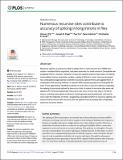Numerous recursive sites contribute to accuracy of splicing in long introns in flies
Author(s)
Adelman, Karen; Pai, Athma A.; Paggi, Joseph M.; Yang, Paul L; Burge, Christopher B
Downloadjournal.pgen.1007588.pdf (3.131Mb)
PUBLISHER_CC
Publisher with Creative Commons License
Creative Commons Attribution
Terms of use
Metadata
Show full item recordAbstract
Recursive splicing, a process by which a single intron is removed from pre-mRNA transcripts in multiple distinct segments, has been observed in a small subset of Drosophila melanogaster introns. However, detection of recursive splicing requires observation of splicing intermediates that are inherently unstable, making it difficult to study. Here we developed new computational approaches to identify recursively spliced introns and applied them, in combination with existing methods, to nascent RNA sequencing data from Drosophila S2 cells. These approaches identified hundreds of novel sites of recursive splicing, expanding the catalog of recursively spliced fly introns by 4-fold. A subset of recursive sites were validated by RT-PCR and sequencing. Recursive sites occur in most very long (> 40 kb) fly introns, including many genes involved in morphogenesis and development, and tend to occur near the midpoints of introns. Suggesting a possible function for recursive splicing, we observe that fly introns with recursive sites are spliced more accurately than comparably sized non-recursive introns.
Date issued
2018-08Department
Massachusetts Institute of Technology. Department of Biological Engineering; Massachusetts Institute of Technology. Department of Biology; Massachusetts Institute of Technology. Department of Electrical Engineering and Computer ScienceJournal
PLOS Genetics
Publisher
Public Library of Science
Citation
Pai, Athma A., Joseph M. Paggi, Paul Yan, Karen Adelman, and Christopher B. Burge. “Numerous Recursive Sites Contribute to Accuracy of Splicing in Long Introns in Flies.” Edited by Hiten D. Madhani. PLOS Genetics 14, no. 8 (August 27, 2018): e1007588.
Version: Final published version
ISSN
1553-7404